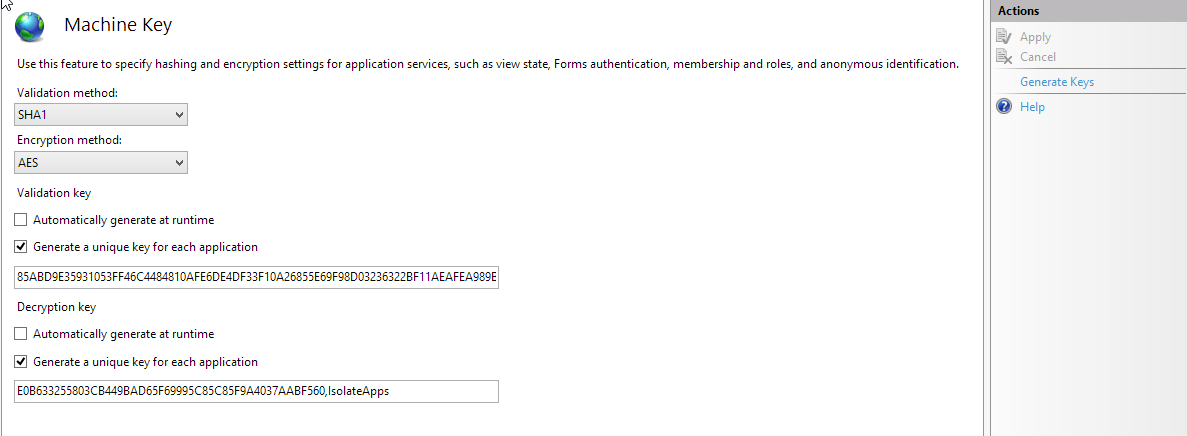Install Guide
Review the Requirements
Install the Dovetail SDK
Dovetail SelfService is an SDK-based application.
If this is the first SDK-based application being installed in your environment, then you must configure your database to support SDK-based applications.
If you have already configured your database for SDK-based applications, then proceed to the next step.
Please see the Dovetail SDK documentation for complete details and instructions on installing and configuring the SDK.
Install Required license keys
- Dovetail SDK license key
- FCINTER Toolkit license key
- FCCS Toolkit license key
- FCSFA Toolkit license key
Dovetail SelfService license key
License keys can be obtained from the My License Keys page on the Dovetail Selfservice portal. If you do not have these keys, contact Dovetail Software, and we will provide them.
License keys an be installed using the Dovetail Software License Installer, which is included with the Dovetail SDK.
Unzip the selfservice.zip file
Apply Schema Changes
The schema changes to be applied are defined in the $dovetailSelfService\config\schema directory
You can change the Clarify schema with either Dovetail SchemaEditor or Clarify's DDEditor or ddcomp.
Prior to making schema changes, backup the current database.
To make these changes using Dovetail SchemaEditor:
- Edit the .SchemaEditor file
- Set the database connection information.
- Set the inputFilePath to $dovetailSelfService\source\config\schema\selfservice.schemascript.xml
- Preview the changes (SchemaEditor.exe -p).
- Apply the changes (SchemaEditor.exe -a).
Edit and Import Data Files
Edit the data files found in the $dovetailSelfService\source\config\dat directory:
- password_reset.dat - defines the contents sent via email when a user requests to reset their password. Likely, this file does not need to be edited.
- auto_dest_rule.dat - defines where selfservices cases are routed to when created or reopened. This file should be edited to be specific to your queus(s) and business processes. Additional Information.
- selfservice-menus-list.dat
- activity_codes.dat - Custom activity codes, including
Change Severity - feedback.dat - Application lists and Auto-Destination Rule for the Feedback functionality
- request-access.dat - Adds
Registerto the Task Type application list - selfservice-menus-list.dat -
SelfService Menususer-defined list
To import the data files using Dovetail ArchiveManager (DIET) or dataex
Execute the following command:
<importTool> -user_name <user> -password <pass> -db_server <serv> -db_name <db> -imp <file>
where:
<importTool> is the import tool, such as diet.exe or dataex.exe
<user> is the system administrator user
<pass> is the system administrator password
<serv> is the database server name
<db> is the database name
<file> is the name of the file to import. If the <file> is not in the current directory, specify the path to the directory it is in.
Dovetail Seeker Configuration
Dovetail Seeker is the search engine that powers the search capabilities of Dovetail SelfService. It is a required dependency of Dovetail SelfService. Follow the installation instructions provided with Dovetail Seeker.
From Seeker's baseline documentSpecifications.xml file, the following specifications should be used:
- cases
Application Configuration
Edit the $dovetailSelfService\app\appSettings.config file, setting the following configuration keys for your environment:
| Key | Default | Comments |
|---|---|---|
| WebsiteSettings.PublicRootUrl | http://localhost/selfservice/ | The public facing rool url of the application |
| WebsiteSettings.IsPublicRootVirtual | true | Is this application installed as a virtual directory? |
| DovetailDatabaseSettings.Type | mssql | Your database type. Either mssql or oracle |
| DovetailDatabaseSettings. ConnectionString |
Data Source=host.domain.local;Initial Catalog=mobilecl125;User Id=dovetailapp;Password=password | Database connection string |
| DovetailDatabaseSettings. SessionTimeoutInMinutes |
60 | This controls the internal Clarify Session object timeout, which makes things faster on every page load. After this time period, if the user is still authenticated, a new Clarify Session is automatically created, and the app works as expected. To control the authentication timeout period, edit the forms timeout setting in the web.config file. |
| DovetailDatabaseSettings. ApplicationUsername |
sa | A valid Clarify username used by the application. Additional Information |
| HistorySettings. MergeCaseHistoryChildSubcases |
false | When displaying case history, should subcase entries be included as well |
| AttachmentSettings.FilePath | c:\DovetailCRM\attach | Root directory for storage of file attachments |
| AttachmentSettings.AttachmentMode | ModeB | Specifies which sub-folder mode should be used when saving file attachments. Additional Information |
| AttachmentSettings.ExcludeExtensions | ade,adp,app,asp, aspx,bas,bat,chm, class,cmd,com,cpl, crt,dll,exe,fxp, hlp,hta,ins,isp, js,jse,lnk,mda, mdb,mde,mdt,mdw, mdz,msc,msi,msp, mst,ops,pcd,pif, prf,prg,reg,scf, scr,sct,shb,shs, url,vb,vbe,vbs, wsc,wsf,wsh | Comma separated list of file extensions that are not allowed to be uploaded |
| SearchSettings.SearchServiceUrl | http://localhost/seeker | URL for Dovetail Seeker |
| SearchSettings. ExcludedSearchDomains |
Comma separated list of search domains that should be excluded from the general search page. | |
| SelfServiceSettings.SearchPageSize | 20 | Number of search results to show per page |
| SelfServiceSettings. AutoDispatchOperation |
WEB_DISPATCH | Auto-destination operation used when auto-routing cases when they are created or re-opened. Additional Information |
| SelfServiceSettings. IncludePerformedByDetailsForContactActions |
true | Should activity entries include the "Performed By Contact" details? This is useful when using the Clarify Client. |
| PasswordSettings. MinimumPasswordLengthOn |
true | Is there a minimum password length? |
| PasswordSettings.MinimumPasswordLength | 6 | Minimum password length |
| PasswordSettings. UsernameCantBePasswordOn |
false | Disallow the password from containing the username |
| PasswordSettings. RequireSpecialCharsOn |
false | Require a special character (!@#$%^&*(){}[].-\/) in the password |
| PasswordSettings. RequireMixedCaseOn |
false | Require upper and lowercase letters in the passsword |
| PasswordSettings. RequireNumbersOn |
false | Require a number in the password |
| PasswordSettings. RequireLettersOn |
false | Require a letter in the password |
| AttachmentSettings. ExcludeExtensions |
List of values | A comma separated list of file extensions. Files with one of these file extensions are blocked from being uploaded as a file attachment. |
| SelfServiceSettings. CaseSeverityHelpSolutionId |
1 | ID Number of the Solution used for the Case Severity Help content |
| SelfServiceSettings. RequestAccessSolutionId |
1 | ID Number of the Solution used for the Request Access - Success content |
| SelfServiceSettings. HomeCaseCount |
3 | Number of cases to be displayed in the Home page case listing |
| SelfServiceSettings. HomeSolutionId |
2 | ID Number of the Solution used for the Home page content |
| SelfServiceSettings. MenuListTitle |
Selfservice Menus | The name of the user-defined list used for building dynamic menus |
| SelfServiceSettings. ChangeSeverityEventID |
1007 | Event ID used when calculating time bomb flags for Change Severity activity |
| ActionItemSettings. DueDateNumberOfDaysAfterCreation |
7.0 | When action items are created the due date will be set by adding this value of days to the creation time |
| ActionItemSettings. FeedbackType |
Feedback | Type of Action Item to be used for Feedback |
| ActionItemSettings. RequestAccessType |
Register | Type of Action Item to be used for Register / Request Access |
| SolutionComments. FeatureEnabled |
true | Enable/disable solution commenting in the application |
| FeedbackActionItem. FeatureEnabled |
true | Enable/disable feedback functionality in the application |
Amazon S3 Settings
These settings apply when using Dovetail Agent 5.x (or higher), and images are stored on Amazon S3.
| Key | Default | Comments |
|---|---|---|
| S3Settings.AWSId | Your Amazon Access Key ID. | |
| S3Settings.AWSSecret | Your Amazon Secret Access Key. | |
| S3Settings.Bucket | S3 bucket where files are stored. |
Logging Configuration
Dovetail SelfService uses the Log4net logging library. Logging is configured within the $dovetailSelfService\app\selfservice.log4net file. The default logging settings are probably fine to start. The log4net website has more details on specific log4net configuration.
32-bit server setup
Contact authentication for web users is platform dependent and contained in fc_crypt2.dll. There are two versions of this file included with the application. The correct version needs to be in the application's bin directory.
If the app is running on a 64-bit server, there is nothing to do here. The app as shipped is designed to work on a 64-bit platform.
If the app is running on a 32-bit server:
- In the application's bin directory, rename fc_crypt2.dll to fc_crypt2-original.dll
- Copy the app\fc_crypt2-x86.dll file into app\bin
- Rename app\bin\fc_crypt2-x86.dll to app\bin\fc_crypt2.dll
Web Server Configuration
Configure the IIS web server to support Dovetail SelfService:
Note: The following assumes IIS version 7.5 on Microsoft Windows 7. Your system may vary slightly.
Open the Internet Information Services Manager
- Select Start and Run.
- Enter inetmgr, and then select OK. The Internet Information Services (ISM) console will open.
Create a new application pool
- Right-click on Application Pools, Add Application Pool,
- Name the pool appropriately, such as Dovetail SelfService
- Set the .NET Formawork version to .NET Framework v4.0.x
- Set the Managed Pipeline Mode to Integrated
- Click OK
Create a web application
The following steps are to setup the SelfService application as a virtual directory, such as http://www.MyCompany.com/selfservice
You may also setup the application as a top level web application, such as https://support.MyCompany.com This advanced configuration requires properly configuring the IP address, ports, and bindings. For this type of configuration, the Microsoft TechNet site provides useful information. Or you may also contact Dovetail Support for assistance.
- Expand Sites
- Right-click Default Web Site and select Add Application
- In the Alias text box, type a short name (alias) for the directory into which the Dovetail SelfService product was installed (i.e. selfservice). The alias is what users see as part of the URL path when they are browsing to the Dovetail SelfService web application (for example, http://www.MyCompany.com/selfservice).
- Select the Application Pool that was created above.
- Enter the path, or browse to the directory which contains the Dovetail SelfService web application files, i.e. $dovetailSelfService\app
- Select OK.
Web Configuration
Edit the $dovetailSelfService\app\web.config file, setting the following configuration keys for your environment:
| Key | Default | Comments |
|---|---|---|
| maxRequestLength | 10241 | Maximum size of data (in KB) to be uploaded. Useful for setting file upload size limits. Additional Information |
| maxAllowedContentLength | 10485760 | Maximum size of data (in bytes) to be uploaded. Useful for setting file upload size limits. Additional Information |
| timeout | 21600 | Specifies the amount of time, in integer minutes, after which the authentication cookie expires. |
If the web application was setup as a virtual directory (as opposed to a top level web application), then the httpErrors error paths should be edited to include the virtual directory name. If the virtual directory name is selfservice, then the paths should be edited to include /selfservice. For example:
<error path='/selfservice/content/403.html
Generate machine keys
- From IIS Manager, in the left pane, click on the web application that was just created (selfservice)
- In the main panel, under ASP.NET, click on Machine Key
- Under Validation Key, uncheck Automatically generate at runtime
- Under Decryption Key, uncheck Automatically generate at runtime
- In the right pane, click on Generate Keys
- In the right pane, click on Apply This will write your new keys to the $dovetailSelfService\app\web.config file

Browse to the Dovetail SelfService application
- From IIS Manager, in the left pane, click on the web application that was just created (selfservice)
- In the right pane, under Manage Application, click Browse *.80 (http)
- This should start your default web browser, start the Dovetail SelfService application, and navigate to the Dovetail SelfService Login page.
